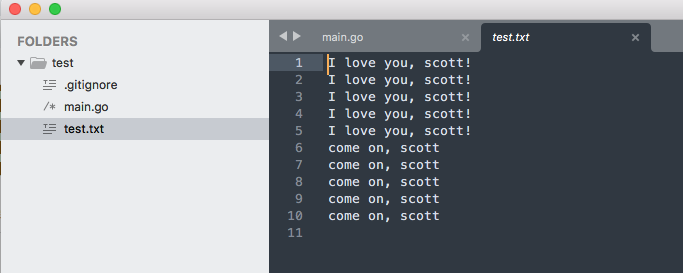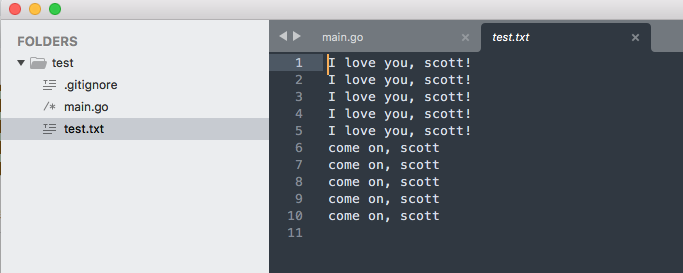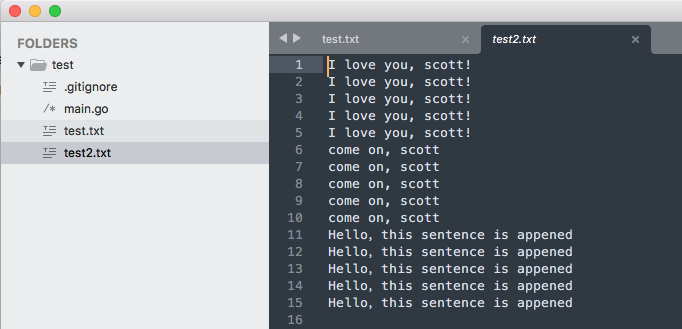file operation
本章主要讲解文件的写入、追加、读取、复制操作
API详解
Go语言的 os 包下有一个 OpenFile 函数,其原型如下所示:
func OpenFile(name string, flag int, perm FileMode) (file *File, err error)
其中 name 是文件的文件名,如果不是在当前路径下运行需要加上具体路径;flag 是文件的处理参数,为 int 类型,根据系统的不同具体值可能有所不同,但是作用是相同的。
下面列举了一些常用的 flag 文件处理参数:
O_RDONLY:只读模式打开文件;O_WRONLY:只写模式打开文件;O_RDWR:读写模式打开文件;O_APPEND:写操作时将数据附加到文件尾部(追加);O_CREATE:如果不存在将创建一个新文件;O_EXCL:和 O_CREATE 配合使用,文件必须不存在,否则返回一个错误;O_SYNC:当进行一系列写操作时,每次都要等待上次的 I/O 操作完成再进行;O_TRUNC:如果可能,在打开时清空文件。
文件的写入
【示例 1】:创建一个新文件 golang.txt,并在其中写入 5 句 "I love you, scott!"
package main
import (
"bufio"
"fmt"
"os"
)
func main() {
//创建一个新文件,写入内容 5 句 “http://c.biancheng.net/golang/”
filePath := "./test.txt"
file, err := os.OpenFile(filePath, os.O_WRONLY|os.O_CREATE, 0666)
if err != nil {
fmt.Println("文件打开失败", err)
}
//及时关闭file句柄
defer file.Close()
//写入文件时,使用带缓存的 *Writer
writer := bufio.NewWriter(file)
for i := 0; i < 5; i++ {
writer.WriteString("I love you, scott!\n")
}
//Flush将缓存的文件真正写入到文件中
writer.Flush()
}
执行成功之后会在当前目录下生成一个 test.txt 文件,打开该文件如下图所示:

文件的追加
【示例 2】:打开一个存在的文件,在原来的内容追加内容“come on, scott”
package main
import (
"bufio"
"fmt"
"os"
)
func main() {
filePath := "./test.txt"
file, err := os.OpenFile(filePath, os.O_WRONLY|os.O_APPEND, 0666)
if err != nil {
fmt.Println("文件打开失败", err)
}
//及时关闭file句柄
defer file.Close()
//写入文件时,使用带缓存的 *Writer
writer := bufio.NewWriter(file)
for i := 0; i < 5; i++ {
writer.WriteString("come on, scott \r\n")
}
//Flush将缓存的文件真正写入到文件中
writer.Flush()
}
执行成功之后,打开 test.txt 文件发现内容追加成功,如下图所示:

文件的读取
【示例 3】:打开一个存在的文件,将原来的内容读出来,显示在终端,并且追加 5 句“Hello,this sentence is appened”。
package main
import (
"bufio"
"fmt"
"io"
"os"
)
func main() {
filePath := "./test.txt"
file, err := os.OpenFile(filePath, os.O_RDWR|os.O_APPEND, 0666)
if err != nil {
fmt.Println("文件打开失败", err)
}
//及时关闭file句柄
defer file.Close()
//读原来文件的内容,并且显示在终端
reader := bufio.NewReader(file)
for {
str, err := reader.ReadString('\n')
if err == io.EOF {
break
}
fmt.Print(str)
}
//写入文件时,使用带缓存的 *Writer
writer := bufio.NewWriter(file)
for i := 0; i < 5; i++ {
writer.WriteString("Hello,this sentence is appened \r\n")
}
//Flush将缓存的文件真正写入到文件中
writer.Flush()
}
执行成功之后,会在控制台打印出文件的内容,并在文件中追加指定的内容,如下图所示:


文件逐行读取

package main
import (
"bufio"
"fmt"
"io"
"os"
"strings"
)
func main() {
fileName := "./a.txt"
file, err := os.OpenFile(fileName, os.O_RDWR, 0666)
if err != nil {
fmt.Println("Open file error!", err)
return
}
defer file.Close()
stat, err := file.Stat()
if err != nil {
panic(err)
}
var size = stat.Size()
fmt.Println("file size=", size)
buf := bufio.NewReader(file)
for {
line, err := buf.ReadString('\n')
line = strings.TrimSpace(line)
fmt.Println(line)
if err != nil {
if err == io.EOF {
fmt.Println("File read ok!")
break
} else {
fmt.Println("Read file error!", err)
return
}
}
}
}
运行结果

从Go 1.1开始,最新也是最简洁的方法就是用bufio.Scanner 请看示例
文件的复制
【示例 4】:编写一个程序,将一个文件的内容复制到另外一个文件(注:仅test.txt存在)
package main
import (
"fmt"
"io/ioutil"
)
func main() {
file1Path := "./test.txt"
file2Path := "./test2.txt"
data, err := ioutil.ReadFile(file1Path)
if err != nil {
fmt.Printf("文件打开失败=%v\n", err)
return
}
err = ioutil.WriteFile(file2Path, data, 0666)
if err != nil {
fmt.Printf("文件打开失败=%v\n", err)
}
}
执行成功后,发现内容已经复制成功,如下图所示:

utils
关于文件的常见操作,我已经封装成了API
使用时引入package即可
import (
"github.com/scott-x/gutils/fs"
)
API List:
func Dir() string: return the exec binary file folderfunc RemoveAll(folder string): rm -rffunc RemoveFile(file string): remove one filefunc Rename(oldName, newName string):rename the file or folderfunc WriteBuf(file, data string): wirte a string data into the filefunc WriteString(file, data string)wirte a string data into the filefunc Copy(from, to string): copy file, must specify what to it is.func CopyFile(srcName, dstName string) (written int64, err error):copy filefunc CopyAndReplace(inputFile, outputFile string, replace map[string]string):copy and replacefunc CreateDirIfNotExist(dir string): similar likemkdir -p /a/b/cfunc CopyFolder(src, des string) error:copy folder, for example:CopyFolder("/Users/apple/go/src/github.com/scott-x/gutils", "/Users/apple/desktop/a"):copy all files from gutils to foldera, not include foldergutilsfunc IsExist(file string) bool: check file or folder if existsfunc ReadAndReplace(file string, replace map[string]string) error: read file and replace it's content withmap[string]string{"old1":"new1","old2":"new2"}func ReadFile1(file string) (string, error): read the file and get the string contentfunc GetRunningFolder() string: get running folder, same as linux's commandpwdfunc GetEnv(env string) string:get the environment of the systemfunc NewFile(filePath string): create filefunc InsertAfter(insert *model.Insert):insert after with replace functionfunc InsertBefore(insert *model.Insert):insert before with replace functionfunc CheckFileType(file string) int: 0 indicates file, 1 indicates folder, -1 means doesn't exist.func IsDirectory(path string) (bool, error): if path doesn't exist or path is a file, it will return false.func FileType(filename string) int:0 folder, 1 file, 0 error.func List(folder string) []string: list the folder and files in current folder, doesn't loop inner folder.func ListFiles(folder string) []string:just list the files in current folderfunc ListFolder(folder string) []string:only list folder in current folderfunc ListAll(folder string, ignore []string) ([]string, error): list all, but will ignore the matched substring in the full path.func ListAllWithFileHeaders(folders []string) (*INFOS, int64, error):func Zip(zipName string, Base string, files []string): zip a file,Basewill be removed.func ZipWithBar(z *ZIP): zip with progress barfunc Tab(n int) string: tabale nfunc ReadJson(filename string) func(string) interface{}: read the configuration of json, return a method, with which we can get the related value.func ModifyAttrOfJson_STRING(filename string, key string, value string): modify the string valuefunc ModifyAttrOfJson_FLOAT64(filename string, key string, value float64): modify the data of float64func MD5(file string) string: md5 file checksumfunc GetExpectedPath(folder,re string) string: it will loop the folder, and return the file/folder that 1st matches re, will return "" if not match.func LastModify(pth string) string: get the time stamp that the file was last modified(string format)
Variable:
fs.HOMEfs.DESKTOP